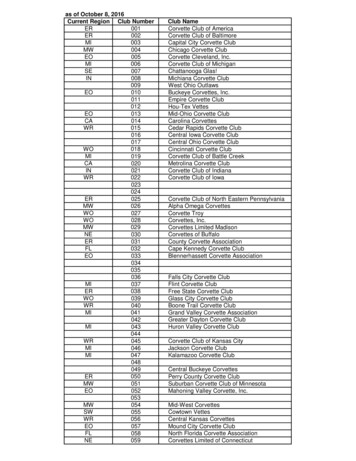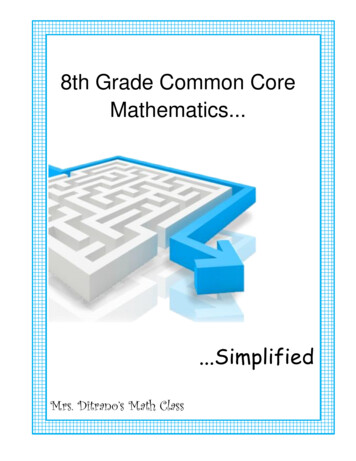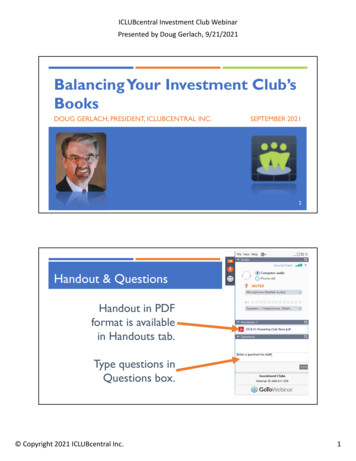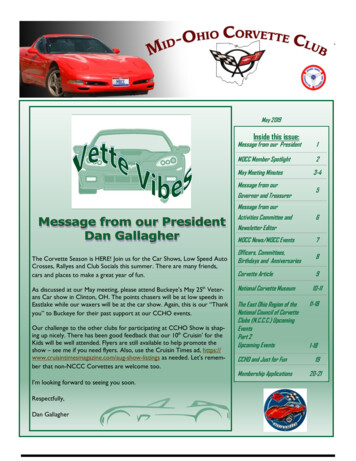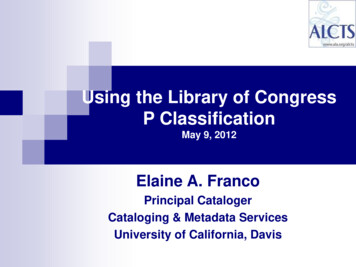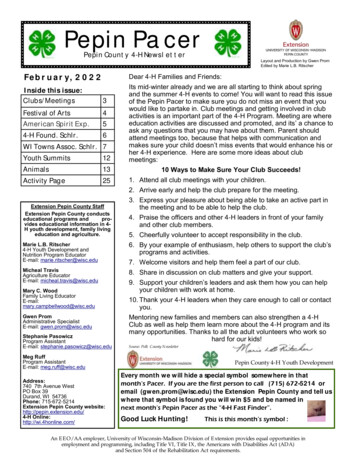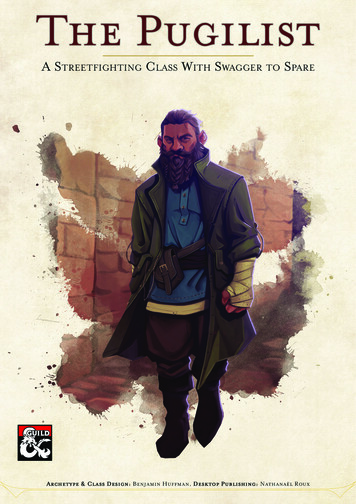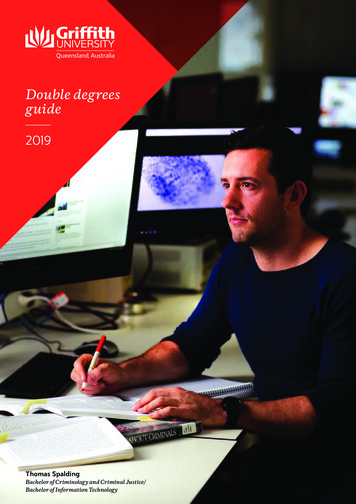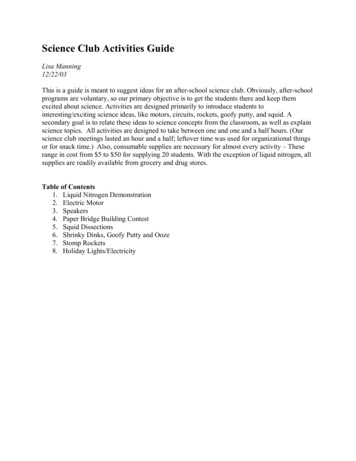
Transcription
Science Club Activities GuideLisa Manning12/22/03This is a guide is meant to suggest ideas for an after-school science club. Obviously, after-schoolprograms are voluntary, so our primary objective is to get the students there and keep themexcited about science. Activities are designed primarily to introduce students tointeresting/exciting science ideas, like motors, circuits, rockets, goofy putty, and squid. Asecondary goal is to relate these ideas to science concepts from the classroom, as well as explainscience topics. All activities are designed to take between one and one and a half hours. (Ourscience club meetings lasted an hour and a half; leftover time was used for organizational thingsor for snack time.) Also, consumable supplies are necessary for almost every activity – Theserange in cost from 5 to 50 for supplying 20 students. With the exception of liquid nitrogen, allsupplies are readily available from grocery and drug stores.Table of Contents1. Liquid Nitrogen Demonstration2. Electric Motor3. Speakers4. Paper Bridge Building Contest5. Squid Dissections6. Shrinky Dinks, Goofy Putty and Ooze7. Stomp Rockets8. Holiday Lights/Electricity
Liquid Nitrogen DemonstrationThis is an excellent first-day demo because it grabs the students’ attention and introducesmany science concepts in an appealing way. It includes creating ice cream on the spot, eatingfreeze dried marshmallows, shattering a carnation, seeing a balloon deflate, and breakingracquetballs.Science Topics covered: phases of matter, density, and elasticityMaterialsLiquid Nitrogen (available at colleges, universities, or anyplace where there is a chemistry orphysics laboratory. Caution: Liquid nitrogen is very cold and poses a severe frostbite risk. Makesure you keep it a safe distance from students and take necessary safety precautions. You alsoneed a dewar to hold the liquid nitrogen and keep it cold, as well as insulated gloves for theperson handling the liquid nitrogen. )VERY IMPORTANT: See the following web page for safety details andpossible trouble spots: http://webs.wichita.edu/facsme/nitro/safe.htmMetal tongsSeveral Metal pie plates (or other shallow containers for holding liquid nitrogen)Plastic Bucket (or other deep container for holding liquid nitrogen)MarshmallowsCarnationsBalloonTest tube or clear plastic soda bottle2 RacquetballsIce Cream Supplies (1/2 gallon, serves about 20 people):Large metal mixing bowlMeasuring cupsLarge Wooden spoonPaper towelsPlastic cups with spoons/ice cream conescream base:4 cups heavy cream 1 ½ cups half and half1 3/4 cups sugarberry mixture:1 quart frozen strawberries that have been allowed to thaw or fresh strawberries, mashed½ cup sugarTotal cost: About 25 for ice cream supplies, 5/liter for liquid nitrogen2
Supervisor Activity guide1. Tell the students that you will be working with liquid nitrogen. Perhaps ask them if theyhave seen a liquid nitrogen demonstration before, or if they know what nitrogen is.Caution them that liquid nitrogen is so very cold that it will give them frostbiteimmediately, so not to touch it, and to be very cautious.2. Pour liquid nitrogen into bucket about 2-3 inches deep. Place one racquetball in thenitrogen. Leave it there while you perform other demonstrations, turning it occasionallyto ensure the ball gets cold everywhere.3. Place marshmallows one layer deep on a pie plate. Pour liquid nitrogen slowly over themarshmallows and stir with a wooden spoon until the marshmallows no longer yieldunder pressure.4. Allow the students to eat a marshmallow. The ‘mallows will be quite cold and crunchy,similar to the marshmallows in Lucky Charms cereal. Ask the students to describe howthe taste and the texture. Ask them why they think the ‘mallow is cold. Why it iscrunchy?5. Next, pour some more nitrogen into a pie pan, and place the top of a carnation into thenitrogen. Stir the flower around by the stem until the petals harden or freeze.6. Ask a student to touch the carnation petals (it’s safe). The petals will be rock hard. Ask astudent to grasp the top of the flower, or hit the top of the flower on the desk. The petalswill shatter. Why does the flower get hard? What words could you use to describe it?(Brittle, frozen)7. Pour some more liquid nitrogen into the pie pan. Blow up the balloon, but make sure theballoon is small enough to fit inside the pie pan. DO NOT TIE THE BALLOON. Instead,stretch the mouth of the balloon over the mouth of the test tube so it forms an airtightseal.8. Place the balloon inside the pie pan and using the wooden spoon press on the balloon.Turn the balloon over a few times to ensure the entire balloon gets cold. The balloon willdeflate. In the bottom of the test tube, there will be ‘liquid air’. As the balloon warms upit will re-inflate. Why does the balloon deflate if there is no hole in the balloon? Wheredoes the liquid (not water) in the test tube come from? Why does the balloon re-inflatewhen it gets warm again?9. Keep all ingredients cold! Make sure the sugar is dissolvedin the cream base. Pour the cream base into a large metalbowl. Add one to two liters of liquid nitrogen and stirvigorously. When the cream has thickened, add the berrymixture and more nitrogen, if necessary. Continue to stiruntil the nitrogen has evaporated (the fog has disappeared).The recipe does not keep well and is best if consumedimmediately. If it begins to melt before everyone is served,simply add more liquid nitrogen.10. Dispense into cups/cones. What makes the ice cream cold?What is the fog that you see?11. Use tongs to retrieve racquetball that has been chilling in liquid nitrogen. Ask students topredict what might happen to the ball when you drop it. Drop a normal racquetball atroom temperature. (It bounces) Drop the normal racquetball and the ‘frozen’ racquetball3
side by side. (the cold racquetball will shatter.) Why does the cold ball shatter? What haschanged about the ball? How is this similar to the carnation petals? To the marshmallow?12. Being careful to avoid students, you can carefully pour the remaining liquid nitrogen onthe floor, to create a ‘fog’. This is safe as long as liquid nitrogen is not poured directly onpeople’s feet.Science behind the demo:Physical properties of NitrogenBoiling Point at 1atmFreezing Point at 1atmDensity of the gas at 21.1 and 1atm-195.8 -209.9 1.153 kg/m3Nitrogen is about 78% of the volume of the atmosphere. By decreasing thetemperature/increasing the pressure, nitrogen can be changed from its gaseous phase (at roomtemperature/pressure) to liquid phase. Liquid nitrogen is very cold; at normal atmosphericpressure it is –196 degrees Celsius. We breathe nitrogen everyday in our air, and liquid nitrogenonly becomes dangerous if it splashes on your skin and causes frostbite or too much of itevaporates into a closed environment and there is not enough oxygen to breathe.An important concept for students to realize is that just like water boils when heated to 100degrees Celsius and changes phase into water vapor, liquid nitrogen boils when heated to –196degrees Celsius and turns into gaseous nitrogen. But since room temperature is ALWAYS above–196 degrees, liquid nitrogen is always boiling at atmospheric pressure. Of course, by increasingthe pressure we can increase the temperature at which the liquid will boil. So liquid nitrogen canbe stored by keeping it at a very high pressure where it won’t boil at room temperature. That iswhy liquid nitrogen and other gases are stored in high-pressure tanks. This concept is closelyrelated to density, as well. When matter is heated, kinetic energy is added to the atoms/moleculesthat make up the material. In a solid, the matter vibrates but doesn’t change shape. In a liquid, themolecules squirm around each other, slipping and sliding around in close contact. In a gas, themolecules are separated from each other and go whizzing about, bouncing off the walls. Ingeneral, solids have the highest density, while gases have the lowest.Explaining the demos:When liquid nitrogen is poured over the marshmallows, all of the water in the ‘mallowsinstantly freezes. The normally spongy texture becomes hard, which leads to the crunchytexture. If the marshmallow is allowed to warm up again, it will taste and feel like a normalmarshmallow again. Also, the extreme cold changes the elasticity of the marshmallow.Normally, elastic materials bend and store the energy from an impact and release it by exerting a‘restoring force’ in the opposite direction. When these materials get very cold they no longerbend, but instead they break or shatter, and no longer store elastic energy. They become brittle orinelastic.Similarly, the nitrogen freezes all of the water in the carnation petals, which makes the petalsbrittle and easily shattered. This is the same reason why the racquetball shatters, too.The balloon shrinks when you put it in liquid nitrogen because as the gaseous air (80%nitrogen) in the balloon cools, the molecules slow down and take up less volume. The air4
becomes more and more dense until the molecules are all very close to each other and the gasturns into a liquid. Liquid air is what you see in the bottom of the test tube. It is important for thestudents to realize that no air has left the balloon/test tube. It has simply changed phase. To provethis, when the balloon warms back up, the liquid will boil and turn into gaseous air again and reinflate the balloon.Liquid Nitrogen makes good ice cream for two reasons:1) The mix freezes very quickly, so you get small crystals and a very creamy texture.2) The evaporating Liquid N2 aerates (nitrogenates?) the mixture, so it doesn't end up as a frozenlump.When you add the liquid nitrogen to the cream base (which is mostly water) it cools the wateruntil it freezes. Conversely, the water warms the liquid nitrogen and makes it boil, creating liquidnitrogen. The fog that you see is water particles in the air that are condensed into water by thevery cold liquid nitrogen (The fog is not liquid nitrogen itself).Uses of Nitrogen:Nitrogen finds use in diverse commercial applications, including:Chemical Processing . to inert vessels and oxygen-sensitive chemicals, creating an oxygen-deficientenvironment that reduces safety hazards; to propel liquids through pipelines; and to manufactureammonia.Food . to extend shelf-life in packaged foods by preventing spoilage from oxidation, mold growth,moisture migration and insect infestation; to rapidly freeze; and to refrigerate perishables during transport.Petroleum Recovery and Refining . to improve recovery and maintain pressure in oil and gasreservoirs; to blanket storage tanks and product loading/unloading; to purge pipelines; and to strip volatileorganic compounds (VOCs) from waste streams or to cool vent streams. Controlling VOC emissionshelps refiners comply with U.S. Clean Air Act requirements.Metal Production and Fabrication . to protect metals such as steel, copper and aluminum duringannealing, carburizing and sintering operations in high temperature furnaces; to cool extrusion dies; andto shrink fit metal parts; utilized as a purge gas with stainless steel tube welding. Also used to supportplasma cutting.Electronics . to prevent oxidation in the manufacture of semiconductors and printed circuits; and toenhance solvent recovery systems by eliminating the use of chlorofluorocarbons for cleanup.Glass Manufacturing . to cool furnace electrodes and prevent oxidation during manufacturing; and tolower air temperatures for optimum cooling rates.Research and Health Services . to freeze and preserve blood, tissue, semen and other biologicalspecimens; to freeze and destroy diseased tissue in cryosurgery and dermatology; and to pre-cool orinsulate Magnetic Resonance Imaging (MRI), conserving the more costly helium.Construction . to suppress the pour temperature of concrete mixtures, inhibiting the formation ofcracks; and to stabilize the ground as in the restoration of the Leaning Tower of m.htmwww.chem.northwestern.edu/ ent5
Shoestring Electric MotorStudents may have seen this before on Beakman’s World, or at the Exploratorium. It is a niftylittle motor that students can build out of ordinary everyday stuff. A lot of the instructions mustbe followed precisely to get this motor to work, and students usually need a fair amount of oneon-one help to troubleshoot. It is nice to have extra helpers around for this activity.Science Topics covered: Electricity, MagnetismMaterials for EACH electromagnet'D' Cell Alkaline Battery1-2 meters of Heavy Gauge Magnet Wire (the kind with red enamel insulation, not plasticcoated) (available at Radio Shack)One iron nail (2-5 inches long)Fine SandpaperRubber BandClear TapeSmall paper clipsMaterials Required for EACH motor:'D' Cell Alkaline BatteryPaper CupRubber BandClear TapeTwo Large Metal Paper Clips1 meter Heavy Gauge Magnet WireOne or Two Rectangular Ceramic Magnets (available at Radio Shack)Toilet Paper Tube, Test tube, or other cylindrical objectFine SandpaperOptional: Glue, Small Block of Wood for BaseSupervisor Activity guide:To prepare students for this activity, ask them about electricity – where do they use electricity?What does it do? Ask them what a motor does (converts electrical energy into mechanicalenergy). Can they give an example of a motor? What are magnets? What properties do theyhave?This is also a good time to discuss positive and negative charges, and north and south poles on amagnet. Do positive and negative charges attract or repel? What about north and south poles?To help the students understand electromagnets, it may be helpful to have them construct anelectromagnet. This shows them that electricity makes a magnetic field. The ends of the copper wire need to be exposed so that the battery can make a goodelectrical connection. Use sandpaper to sand off the insulation all the way around thewire. Neatly wrap the wire around the nail. The more wire you wrap around the nail, thestronger your electromagnet will be. Make certain that you leave enough of the wireunwound so that you can attach the battery.6
When you wrap the wire around the nail, make certain that you wrap the wire all in onedirection. You need to do this because the direction of a magnet field depends on thedirection of the electric current creating it.Use a rubber band to hold the ends of the wire next to the battery terminals. Secure inplace using clear tape.Use you electromagnet to pick up small paper clips. See how many you can stringtogether.It is a good idea to have one working electric motor to show the kids before they begin. As theyare building the motor, ask them how the different parts of the motor work. Be sure to stress thatthe loop of wire in the motor turns into a magnet just like the electromagnet they just made. Starting about 3 inches from the end of the wire, wrap it 7 times around the toilet papertube. Remove the tube (you don't need it any more). Cut the wire, leaving a 3-inch tailopposite the original starting point. Wrap the two tails around the coil so that the coil isheld together and the two tails extend perpendicular to the coil. See illustration below:Note: Be sure to center the two tails on either side of the coil. Balance is important.You might need to put a drop of glue where the tail meets the coil to prevent slipping. On one tail, use fine sandpaper to completely remove the insulation from the wire. Leaveabout 1/4" of insulation on the end and where the wire meets to coil. On the other tail, laythe coil down flat and lightly sand off the insulation from the top half of the wire only.Again, leave 1/4" of full insulation on the end and where the wire meets the coil.7
Bend the two paper clips into the following shape (needle-nosed pliers may be usefulhere): Turn the paper cup upside down. Place the battery on top of the cup and tape into place.(You may need to break the rim on the bottom of the cup a little to fit the battery intoplace)Use the rubber band to hold the paperclips to the terminals of the "D" Cell battery. Seefinished motor diagram.Stick the ceramic magnet on top of the batteryPlace the coil in the cradle formed by the right ends of the paper clips. You may have togive it a gentle push to get it started, but it should begin to spin rapidly. If it doesn't spin,check to make sure that all of the insulation has been removed from the wire ends. If itspins erratically, make sure that the tails on the coil are centered on the sides of the coil.Note that the motor is "in phase" only when it is held horizontally (as shown in thedrawing).It also helps to bend the ends of the coil a bit so that as it slips right or left, the bendskeep it in the proper position: 8
Here is a diagram of the finished motor: Troubleshooting Guide:The wire should be enamel coated magnet wire. This is solid copper wire with a baked oninsulation, usually red, although it can be clear. Un-insulated wire will not work. Wirewith rubber or plastic insulation will not work without some extra work. Small refrigerator magnets or those rubbery sheet magnets probably won't work. If allyou have is small magnets, try stacking them together. The large rectangular magnetsfrom Radio Shack work very well. If your Radio Shack doesn't carry them (or you don'thave a Radio Shack nearby), try your local hardware store (such as Lowe's or HomeDepot), they usually have a large selection of magnets for doing things like magnetizingtools or hanging tools on walls. The sanding of the coils is probably the trickiest part. Reread these directions and see if9
they correspond with your understanding of these instructions. Take your sandpaper andsand all of the insulation off of one tail of the coil (the wire sticking out from the coil). Itshould be bright and shiny copper all the way around. Now, lay the coil down onsomething that is safe to sand on. On the other tail, sand off all of the insulation on thetop half of the wire. When you get through, the wire should be red on one side and coppercolored on the other. Make the coil per the directions. If the coil is lopsided or the leads coming out either sideare not exactly parallel or don’t come off exactly halfway up the circle, then the coil willnot turn as it should. Make sure your paper clips are good quality metal and are not covered with plastic orrubber. Sand them lightly on the surfaces that contact the battery and on the surfaces thatthe coil lays on. If all else fails, make sure you have a fresh battery -- previous errors in sanding the coilsmay have created a short circuit that drained your battery. Have someone else read the instructions without looking at your construction -sometimes a fresh viewpoint can point out problems and misconceptions.Science Behind the Motor:Wires are made of metals, which are good conductors. This means they carry electricity, orelectric currents. A current is moving electric charges. Metals are good conductors because theyare filled with electrons that are free to move around. (Plastics and other insulators haveelectrons that are stuck to atoms and molecules and can’t move around to carry electric currents.)When you attach a wire to a battery, it causes the electrons (electric charges) to start movinginside the metal, or generating a current.One of the coolest things in science is the fact that electricity and magnetism are very closelyrelated to each other. The movement of electric charges creates a magnetic field. If you couldsee the magnetic field around a wire that has electricity flowing through it, it would look like aseries of circles around the wire. If an electric current is flowing directly towards you, themagnetic field created by it circles around the wire in a counter-clockwise direction. If thedirection of the electric current is reversed, the magnetic field reverses also and circles the wirein a clockwise direction. A quick trick for figuring out the direction of the magnetic field is theright-hand rule: Stick your right thumb in the direction the current is traveling, and the magneticfield goes in the direction your fingers are curled. This is why you have to wrap yourelectromagnet so it always goes in the same direction. If you wrap some of the wire around thenail in one direction and some of the wire in the other direction, the magnetic fields from thedifferent sections fight each other and cancel out, reducing the strength of your magnet.Besides electromagnets, which only work when electricity is flowing through them, thereare permanent magnets. This is what you use to hang stuff on your fridge. Permanent magnetsare ALWAYS magnetic – they don’t need electricity to work. They are made of ferromagnetic10
materials like iron, that have the magnetism ‘frozen in’. Usually this is done by heating up thematerials until they are very hot, using an electromagnet to magnetize them, and then coolingthem down very fast so that they don’t have a chance to go back to normal. Even if one magnetis a permanent magnet and the other is an electromagnet, they still have the same property: Thenorth and south poles of a magnet attract, while two north poles or two south poles repel eachother.Now it becomes clear how the electric motor works: When the un-insulated parts of thecoil make contact with the paper clips, current flows through the coil, making it into anelectromagnet. Since magnets attract, the coil attempts to align itself with the ceramic magnet.However, when the coil turns to face the magnet, contact is broken (because the insulation onone tail is now preventing current flow). Inertia (the principle that an object in motion tends tostay in motion) causes the coil to continue around. When the coil makes are nearly completespin, contact is re-established and the process repeats.Technically (if you look up references on more complex motors), this motor is a single-polepulse motor. More complex motors are created by using more than one coil and more complexset of brushes (the things that connect the coils to the current) so that no matter where the coil isin the spin pattern, at least one coil is always energized and trying to turn the coil assembly toalign with the next magnet.References:http://fly.hiwaay.net/ tromagnet.html11
Speaker ActivityThis is a ‘discovery’ activity, where students are not given exact directions. Instead, they aregiven supplies and attempt many different configurations until they find one that suits theirpurposes. Getting started is the hardest part of this lab: students may need several hints. Be sureto highlight students who are headed in the right direction. This activity works well right afterthe electric motor activity, and uses the same magnets.Science Topics Covered: Electricity, Magnetism, SoundMaterials:Plastic food containersPaper platesPaper/plastic cupsAluminum foilOther miscellaneous paper/plastic materials to act as speaker baseHeavy gauge wire ( 1 meter per groupCeramic magnets (2 – 5 per group)Clear TapeBoom box or radio with external speakers (you need the kind with exposed, ordinary wiresconnecting the speakers to the source)Optional: cow magnetSupervisor Activity GuideThe most difficult part of this activity is encouraging students to figure out what to do forthemselves. When you give them some random supplies and tell them to make a speaker, theyare CONVINCED that they will not be able to do it without your instructions. The key is to givethem information and hints without telling them exactly how to do it.If your group worked on the electric motor recently, it is easier to get started. Ask students,moving charges create what? (a magnet) How did you create an electromagnet in when youmade your electric motor? (Made a coil of wire with batteries at the end) Which way does themagnet point? (This is a tricky point Help students use the right-hand rule to figure out theirmagnets point through the coil. Which way is north and south depends on how they hooked uptheir battery.)Ask them how they got the electric motor to move. With a little coaching, they will figure outthat it was the two magnets (one electromagnet, one permanent magnet) repelling each other thatcaused the motor to turn. Tell them that to make a speaker they need to once again have twomagnets repel each other to make movement.The last concept they need is sound. Ask, What is sound? In physics, sound is simply a vibrationof air. To make sound, all you need is something that is vibrating. That is why a guitar stringmakes noise when you pluck it; the string is vibrating. (Of course, if something is vibrating tooslowly or the amount of vibration is small, then you won’t be able to hear it.) How slow or fastsomething vibrates is called the frequency of the vibration, and corresponds to the pitch (how12
low or high the sound is.) How small or large the vibration is determines the amplitude of thevibration, and corresponds to the volume (how soft or loud the sound is.) So if they want tomake a sound, they must get SOMETHING to vibrate(or move) using electricity.Show the students the boom box. Demonstrate that the radio works by turning on the speakers.Show the students the exposed wires on the back of the boom box. Explain that the wires carryelectricity from the radio to the speakers. In some sense, the wires are carrying the sound in theform of electricity. The job of the speakers is to transform electricity into movement(vibrations), which makes sound. This is almost the same as the job of a motor, to transformelectricity into movement.One important concept for the students to grasp is that the wires from the back of the radio willsupply electricity that is already flowing in a special pattern. (This special pattern is alternatingcurrent, but this concept is too difficult to explain unless the students are already familiar withthe subject.) All the speakers have to do is make small movement based on that electricity. Theradio has already done the hard part.Now, let the students get started! They can use up to 1 meter of wire, 4 magnets, and any of theother supplies they want, and they can test their speaker as many times as they want. (Youprobably want to limit the wire and number of magnets to make it fair – students will soondiscover that more wire and more magnets make it louder ) At the end of the hour (ordesignated time span) the person or group with the loudest speaker wins.Troubleshooting:Keep the volume of the radio in a moderate range – too much volume and your ‘speakers’ couldblow a fuse in the radio.Good Speaker Design/ Things to Suggest/ Science behind speakersIn general, these are the components of a good speaker design:1. Must have a coil of wire (The longer, the better), with the ends of the coil attached to theoutputs from the radio2. The coil of wire should sit right above (or below) the permanent magnets. This causes thetwo magnetic fields to be parallel to each other. Electricity from the radio is alternatingcurrent, which means it rapidly switches direction. When electricity flows in onedirection through the coil, the magnetic field of the electromagnet will be in the SAMEdirection as the permanent magnet, and the two will repel. When the current flows in theopposite direction, the two magnetic fields will be opposite of each other and the two willattract. Thus, the coil and the magnet will vibrate. If the students speakers are not veryloud, one thing to check is how close together their magnet and coil are. The best designis to have the coil ring the permanent magnet without touching it.3. The coil and the magnet should be independently anchored. This means that either thecoil or the magnet should be held still, while the other vibrates against it. This is almostalways a problem for students. Keep reminding them that they want to have somethingvibrate, which means that the two ‘magnets’ must be independent of each other. Theyshould not be taped together.13
4. To amplify the sound, attach a plate or cup or something to the vibrating object (eitherthe coil or the permanent magnet, whichever is not being held still) If the thing you attachis thin and flexible, but not malleable, that will work best. (i.e. a paper plate works betterthan a rock or jello.)5. To direct the sound, make a cone, and attach it to the vibrating object. This funnels thenoise in one direction and makes it easier to hear along that direction.6. Of course, the speaker will get louder if there is longer wire or stronger magnets. A gooddemonstration is to place a cow magnet near the ceramic magnets in the speakers andhear the speakers get louder.14
Human Arch and Paper Bridge Building ContestThis is a relatively simple, yet fun activity. Students love the competition, and are amazed at howmuch weight a few pieces of paper can hold Science concepts: Force, Compression, Load: Live and Dead, Effective use of materialsMaterialsSeveral sheets of plain paper such as photocopier paperScissorsRulerFive paper clips or one meter of tapeSmall weights, such as metal washers, pennies, or film canisters filled with sandSeveral books to support the sides of the bridge above the groundSupervisor Activity GuideThe first activity is a simple icebreaker designed to give the students some intuition about whatmakes a strong bridge. The goal is to build a human arch that doesn't break when someone pullson it. Select three kids. Ask two students to form an arch by extending their arms towards oneanother and pressing their palms against each other. Direct the kids to backup until they are as far apart as possible, without breaking the arch. Ask a third student to GENTLY pull down on the arch. (Keep the pressure on until thearch collapses.) Ask the "arch" what happened. Have them describe what happened to the rest
Liquid Nitrogen (available at colleges, universities, or anyplace where there is a chemistry or physics laboratory. Caution: Liquid nitrogen is very cold and poses a severe frostbite risk. Make sure you keep it a safe distance from
